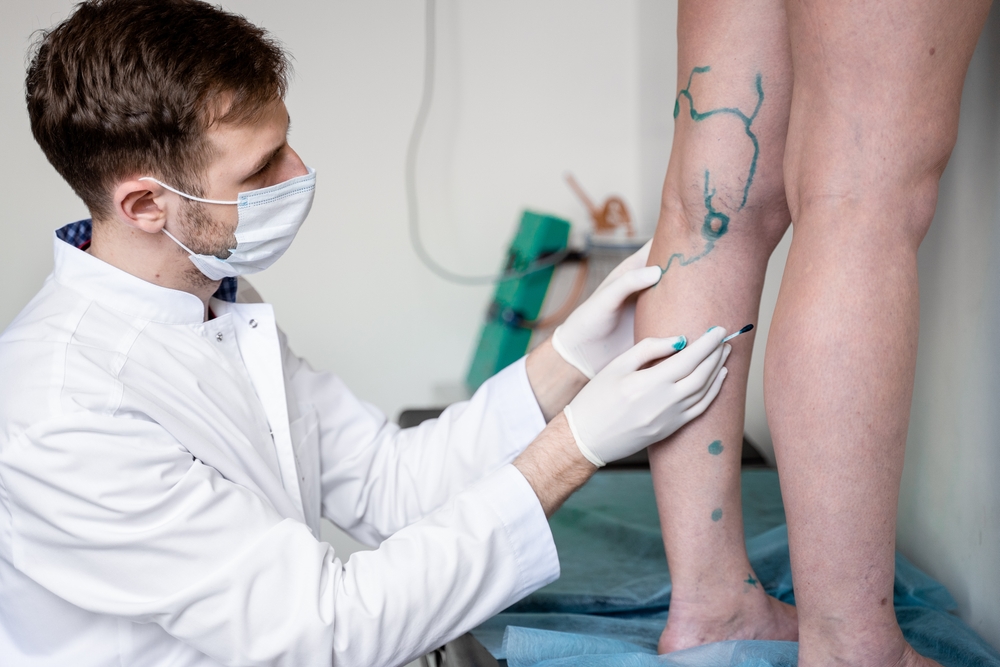
☝️ The most important facts in brief
- A specialist in vascular surgery examines the vascular system thoroughly and performs treatments on arteries, veins and lymph vessels.
- Vascular surgery is a branch of surgery and requires 6 years of specialist training after graduation.
- The most common conditions with which patients consult a vascular surgeon include varicose veins, circulatory disorders, thrombosis and diabetic foot. Heart attacks and strokes are also common reasons for treatment by a vascular surgeon.
- As a vascular surgeon, you use various modern surgical procedures such as angioplasty, stent or bypass operations to improve or restore the function of the affected vessels.
📖 Table of contents
Vascular surgery is a specialised field that deals with the diagnosis, treatment and prevention of vascular diseases. The vascular surgeon uses modern surgical methods to treat the affected vessels. In order to work in this profession, a medical degree and 6 years of further training to become a specialist in vascular surgery are required.
Are you interested in studying medicine?
We will be happy to advise you free of charge about your options for studying medicine, including advice on studying medicine in another EU country, which is fully recognised in Germany.
The tasks of the vascular surgeon
A vascular surgeon treats diseases of the vascular system. He carries out diagnostic examinations and plans individualised treatment together with the patient. Surgical interventions, such as bypass operations and angioplasty, are just as much a part of this as attempts at drug treatment.
As a vascular surgeon, you will work closely with other specialities to ensure multidisciplinary treatment. This is particularly necessary because patients often have other illnesses and the problem of a single illness can also extend across several specialisms.
Becoming a vascular surgery specialist: the training programme
After graduating from high school, it takes at least 12 years to become a specialist in vascular surgery. The training is divided into a six-year medical degree and a six-year specialist training programme.
Study
Although you will learn a lot about veins, arteries and lymphatic vessels on the human medicine course, you will not yet specialise in vascular surgery. Instead, the medical degree programme teaches the basics that specialists in both hospitals and private practice will need later on.
In the two-year pre-clinical part, you will learn about the anatomy and physiology of healthy people and the extent to which the body's systems are disturbed in various diseases. Biology, chemistry and physics are other important topics here.
In the clinical part, you will then familiarise yourself with the various specialist areas. Even if you already know at this point that you want to specialise in vascular surgery, it is important to know the basics of the other areas. Specialists work closely together in the best case scenario. In an emergency, you also need to recognise diseases from other specialist areas and know who to refer your patients to.
Specialist training
Once you have completed your studies and become a doctor, you can now focus on the speciality of vascular surgery. The specialist training required for this takes 6 years and is divided into a 2-year general surgical part and a further specialisation in vascular surgery.
General part
The general part must be completed by specialists from every surgical speciality. Here you will learn important details about surgical procedures, emergency management and many other things you need to know as a surgeon.
Operating theatre preparation, positioning techniques and anaesthesia are just some of the important topics covered during these two years, in which you will acquire extensive specialist knowledge that you can later apply as a doctor in vascular surgery.
Speciality: vascular surgery
In the other 4 years of your training as a specialist in vascular surgery, you will deal with the specific content for this speciality. You will learn in detail how vascular diseases are diagnosed and treated.
You will acquire knowledge of puncture and catheterisation techniques, surgical procedures for treating the diabetic foot, vascular reconstruction and the use of modern imaging techniques such as angiography. After successfully completing these last 4 years, you will have specialised in diseases of the vascular system and will be a vascular surgeon.
Differences between vascular surgery and other surgical specialities
A vascular surgeon is a surgeon who specialises in the vascular system, including arteries, veins and lymphatic vessels. This is not limited to a specific area of the body, but involves all areas of the vascular system, including arteries, veins and lymphatic vessels in the periphery and centrally near the heart.
Accordingly, these specialists must be very familiar with the anatomy of the entire body, whereas other surgical specialities often focus on specific organs or regions of the body.
What diseases do patients come to the vascular surgery department with?
There are a variety of diseases of the arteries, veins and lymphatic vessels that require treatment in vascular surgery. Vascular surgeons treat both acute problems and chronic vascular diseases. The fields of treatment range from aneurysms to varicose veins, circulatory disorders, thrombosis, diabetic foot and complex injuries to the blood vessels.
Due to the great diversity of this speciality, we cannot go into every single disease here, but we have picked out some of the most common ones for you and will now explain them in a little more detail.
Arteriosclerosis
Calcification of the arteries is a common disease. It can be caused by deposits of fat and cholesterol on the walls of blood vessels, narrows the arteries and can lead to blockages. This in turn can lead to serious consequences such as a heart attack or stroke.
In vascular surgery, patients with arteriosclerosis are treated with both drug therapies and surgical interventions. The aim is always to improve blood circulation, prevent complications and help the patient to lead an active life.

Aneurysms
An aneurysm is a bulge or dilation of an artery caused by a weakness in the vessel wall. There is a risk of a rupture occurring at the weak point, which can be life-threatening.
Vascular surgeons diagnose aneurysms using imaging techniques. The associated intervention is also part of the field of vascular surgery. This may involve open surgery or a less invasive surgical and interventional endovascular method to stabilise the affected vessel.
In the case of an aneurysm, early diagnosis and treatment are crucial in order to prevent serious complications and thus protect the lives of those affected.
Thrombosis
Thromboses often occur in the deep veins of the legs. If they detach from there, this can lead to a pulmonary embolism, among other things. Vascular surgeons have various procedures available to treat deep vein thrombosis and venous insufficiency, which is often associated with it. These include thrombolysis with medication and surgery to remove the blood clot.
If a patient is prone to thrombosis due to risk factors, prevention is also important. In this regard, vascular surgery specialists can prescribe anticoagulants, among other things, which must be taken permanently.
Varicose veins
Varicose veins are one of the most common venous disorders. These dilated and tortuous veins usually appear on the legs and can lead to pain and swelling. Modern vascular surgery clinics treat varicose veins with sclerotherapy, laser treatments and, if necessary, surgical procedures. This often results in a significant improvement in the quality of life of affected patients.
Peripheral arterial occlusive disease (paVK)
In this disease, the blood flow in the arteries of the legs is impaired by constrictions. This leads to circulatory disorders and pain when walking. Vascular surgery looks at the findings of PAD and then decides whether treatment with medication, surgical and interventional endovascular procedures or bypass surgery is the best choice.
The aim here is also to improve blood circulation and increase the mobility of patients with the condition. Of course, it is also important to counteract any further deterioration of the condition.
Lymphoedema
Lymphoedema is a swelling caused by an accumulation of lymph fluid in the tissue because the drains in the lymphatic system are blocked. As vascular surgery deals with arteries, veins and lymphatic vessels, lymphoedema also falls within its remit.
Vascular surgery clinics combine various treatment methods for lymphoedema. Manual lymphatic drainage, compression therapy and, in some cases, conventional surgical and interventional procedures are the main methods used to provide relief for patients suffering from lymphoedema.
Venous insufficiency
If the veins cannot transport enough blood back to the heart, this leads to swelling and pain as well as reduced performance. The risk of thrombosis also increases.
The aim of vascular surgery is to provide patients with venous insufficiency with the best possible and gentle treatment that alleviates their symptoms and protects the veins from worsening.
In addition to the usual compression therapy, there is also the option of treating the insufficiency in vascular surgery using conventional surgical methods and attempting to improve the return flow through the venous blood vessels by means of comprehensive vascular surgery.
Diabetic foot
Diabetic foot is a serious complication of diabetes that causes wounds and circulatory disorders in the feet. In vascular surgery, these patients are treated with special wound treatments (so-called revascularisation procedures) and, if necessary, amputations.
The aim is usually to maintain the ability to walk in order to keep the quality of life as high as possible. Patients with diabetes generally receive multidisciplinary treatment through individualised therapies and interventions by various specialists. Vascular surgeons cooperate closely with specialists from the Diabetology and other areas, because diabetes usually affects various systems of the body.
Aortic dissection
Aortic dissection is a life-threatening condition in which the wall layers of the aorta tear. This usually leads to sudden and very severe pain. It is an urgent emergency in vascular surgery that requires rapid action.
Aortic dissection is usually treated by a conventional surgical and interventional procedure, the main aim of which is to stabilise the aorta again, keep blood loss to a minimum and thus save the patient's life.
Methods for examination in vascular surgery
A vascular surgeon is a doctor who specialises in diseases of the vascular system, including the examination methods used to diagnose these diseases. We would now like to introduce you to three of the most important methods used by these specialists.
Angiography
This imaging method is used in vascular surgery to create detailed images of the blood vessels. A specialist in vascular surgery then looks at an angiogram to detect diseases of the vascular system, including constrictions and abnormalities of the arteries and veins, such as aneurysms.
In order to better visualise the vessels, a contrast agent is injected into the bloodstream during angiography. X-ray images are then taken so that the vascular structure can be clearly recognised thanks to the contrast agent.
Duplex sonography
Duplex sonography is a non-invasive ultrasound procedure used by vascular surgeons to examine arteries and veins. It combines two techniques: B-scan sonography and Doppler sonography.
With this method, specialists can visualise both the structure of the vessels and the blood flow in real time. Duplex sonography can be used to recognise various arterial blockages, deep vein thrombosis and venous insufficiency, among other things. This examination in vascular surgery enables a very precise assessment of the affected vessels and helps to plan the appropriate treatment.
Phlebography
Phlebography is a special X-ray procedure and is basically an angiography for the veins. The most common venous disorders include varicose veins, circulatory disorders and deposits on the vessel walls. These can be identified using the contrast medium X-ray during phlebography.
The images obtained during this examination are crucial for further treatment. The doctors in vascular surgery combine conventional surgical procedures and non-invasive methods in the way that is best for the patient concerned.
Treatment methods for diseases of the vascular system
Vascular surgery recognises numerous treatment methods for various vascular diseases. In the case of peripheral arterial occlusive disease (PAOD), for example, vascular surgeons often rely on proven endovascular methods to help patients with angioplasty, balloon dilatation or stent implantation.
For operations on the heart, vascular surgeons often cooperate with the Cardiac surgery and use modern surgical methods to maintain the heart's performance or restore its functionality.
Surgical methods are not always used directly in vascular surgery. In vascular medicine, treatment methods based on medication are used, among other things, to inhibit blood clotting and thus prevent the formation of further blood clots.
The operation can often be performed without large incisions
In modern vascular surgery, the specialists perform both "normal" operations and minimally invasive procedures. For example, thrombosis, diabetic foot, heart attacks and peripheral arterial occlusive disease (PAOD) can be treated with the help of a catheter. An operation or surgical procedure therefore does not always involve a large incision.
Catheter access via a large vein reduces the recovery time and lowers the risk of complications.
Free information material
Studying medicine abroad 🎉
Order your info pack now, find out more about the Studying medicine abroad and get started as a medical student!





